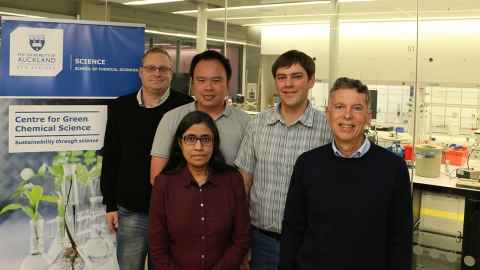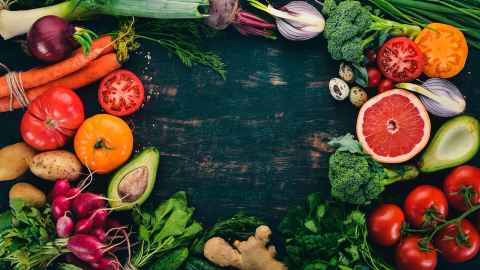Greening our food production and supply chains
25 November 2020
The team at the Centre for Green Chemical Science is finding new ways to make the food we eat more sustainable.

NEARLY ONE IN ten people in the world experienced severe levels of food insecurity in 2019. Meanwhile, a third of all food produced globally (around 1.3 billion tonnes) is wasted, each year. It may be thrown out by consumers and retailers or spoiled during harvesting or transportation.
These are statistics highlighted by the United Nations, which aims to reduce food waste along production and supply chains by 2030, as part of its Sustainable Development Goals (SDGs).
At the University of Auckland, the Centre for Green Chemical Science led by Professor James Wright, aims to support these SDGs. The individual research projects of its four Deputy Directors share a common goal to contribute to the solution of precisely this global problem.
Dr Ivanhoe Leung, Dr Viji Sarojini, Associate Professor Jon Sperry and Dr Cameron Weber are finding new ways to reduce food waste or reuse that which is currently considered food waste. But importantly, these ways involve developing chemical products and processes which are sustainable and harmless to the environment.
The Centre’s team of 25 members from across multiple faculties, carries out interdisciplinary research on other issues too, such as pollution elimination and sustainable energy production.
Keeping fresh food fresh for longer
More than 20 percent of fruits and vegetables produced globally is lost between harvest and retail, according to the UN Food and Agriculture Organisation. Significant quantities of food are also going to waste in retail stores and after purchase.
Ivanhoe is exploring a specific way of reducing fresh produce waste by slowing down the ripening and browning processes of fruits and vegetables so they stay fresh for longer, whether during transport, on our supermarket shelves or benchtops at home.
The two research projects, funded by Marsden Fast-Start Fund grants, involve studying plant enzymes that control these processes in fruits and vegetables, to learn how the plant regulates the ripening and what natural products could be used to slow this process down.
Learning more about the browning process, that is when a cut piece of fruit slowly turns brown over time, and potentially controlling it, is especially applicable to prepared fresh fruit and vegetables, which have a more limited shelf life. “Our aim is to understand the biological processes at the protein level that are involved in ripening and browning, and to use our understanding to design and develop chemicals that can slow down these processes,” Ivanhoe explains.
“Millions of tonnes of fresh produce and cut fruits are being thrown away every year, so if we could regulate the ripening and browning processes, we could help make agriculture more sustainable,” he says, reducing the food being thrown away because it overripened during transportation and was damaged.

Frozen food gets damaged too
Viji’s research is currently targeting ways of preventing the loss of a part of frozen food that you may not even realise is being lost, but you’ve probably tasted it. As frozen food products thaw, drip loss occurs, causing nutrients to be lost along with the fluid which adversely affects flavour and texture too.
“When you freeze something, naturally ice crystals form, and when you thaw it, the ice crystals melt, which causes some of the ruptured cell contents to ooze out along with the water,” Viji explains. With meat being one of New Zealand’s major exports, she says, “there’s a lot of product recall from exported frozen meat because of drip loss, among other things”.
Viji is studying how anti-freeze peptides (small proteins) can be used to potentially minimize freeze-thaw damage in frozen meats, fruits and vegetables. “We look at what is in nature and as synthetic peptide chemists, we can come to the lab and make our own peptides that imitate the function of naturally occurring, more complex anti-freeze proteins.”
In collaboration with AgResearch, her PhD student on this project, Charles Kong who graduated in 2016, synthesized these peptides and tested them on a range of fruit and vegetables, where he found freeze-thaw damage from large ice crystals was minimized. This helped to reduce drip loss and the loss of nutrition, says Viji.
“ ...if we could regulate
the ripening and
browning processes,
we could help make
agriculture more
sustainable.
Let nothing go to waste
As Ivanhoe and Viji’s respective research focuses on ways of reducing food waste, Jon’s research is centred around how to extract things of value from food waste products. Specifically, he is studying crustacean shell waste, as these shells have a valuable component called chitin, a biopolymer that contains nitrogen.
“The reason it’s very valuable is because it has atmospheric nitrogen which has been biologically ‘fixed’ or converted into molecular compounds – so nature itself has fixed that nitrogen into a usable form,” says Jon, whereas artificially fixing nitrogen is very energy intensive. “The man-made version of doing this is the Haber Process, where nitrogen gas, which is very inert, is converted into ammonia which is used to basically feed the planet – it’s the base chemical for fertilizer production.”
Currently, these chitin-rich shells are thrown away as waste, often ending up in landfill or back in the ocean. In animals such as insects and crustaceans it is chitin that gives strength to their exoskeleton, which for some consists of a shell. Jon says the current uses for shellfish waste are limited. “You can grind it down and because it has a lot of calcium carbonate in it, you can sell it as chicken grit, to put in chicken feed to help with their bone development but it just has really low value applications at the moment.”
But why crustacean shells? “The shell waste is really accessible because there’s about ten million tons of that produced annually every year,” he says.
Funded by MBIE catalyst grants, Jon’s been working together with the National University of Singapore to find ways to break down the chitin component in the shells in an energy efficient way. So far, the team has published findings that show chitin can be degraded down into one particular chemical that is very useful. “You can subsequently convert that chemical into a variety of interesting products that you would not be able to get any other way.”
Currently they are determining what these new products could be used for through biological testing. Some are powerful antioxidants, but they are not sure yet if they are safe for consumption. “This is an antioxidant that we can basically get from a waste shell product.”
Cameron will commence research on this project too, exploring different sustainable methods to break the chitin down to unlock valuable compounds, but by using alternative solvents or mechanical energy rendering heating processes unnecessary. “Then we could use those processes to see if we can make smaller molecules from chitin which hopefully could then be converted into some of the small molecule products that Jon mentioned,” he says.
This is where Cameron’s current research on forestry waste may help him in his future work on chitin. “Often for forestry waste, high temperatures and highly acidic or highly basic processes are used to extract things out and you get a lot of decomposition and degradation as a result. We’re trying to approach it at preferably low temperatures using non-hazardous materials,” he says.
“Some of these approaches can then also be applied to things like food waste, as chitin structurally is quite similar to cellulose so there’s the potential that some of these processes could also be applicable to other areas as well.” As it lays down the green and clean pavers in the pathway to a sustainable world, the Centre’s research has never been more vital than it is today and alongside this, it focuses on connecting with industry, public outreach and of course, teaching its students.
Ivanhoe says they prepare their undergraduate chemistry students to think broadly, beyond the scientific issues in sustainability. “We get them to think about the social side as well as the economical side of things – because it won’t work if you only have a scientific solution that is economically viable but not socially acceptable.”

inSCight
This article appears in the December 2020 edition of inSCight, the print magazine for Faculty of Science alumni. View more articles from inSCight.
Contact inSCight.